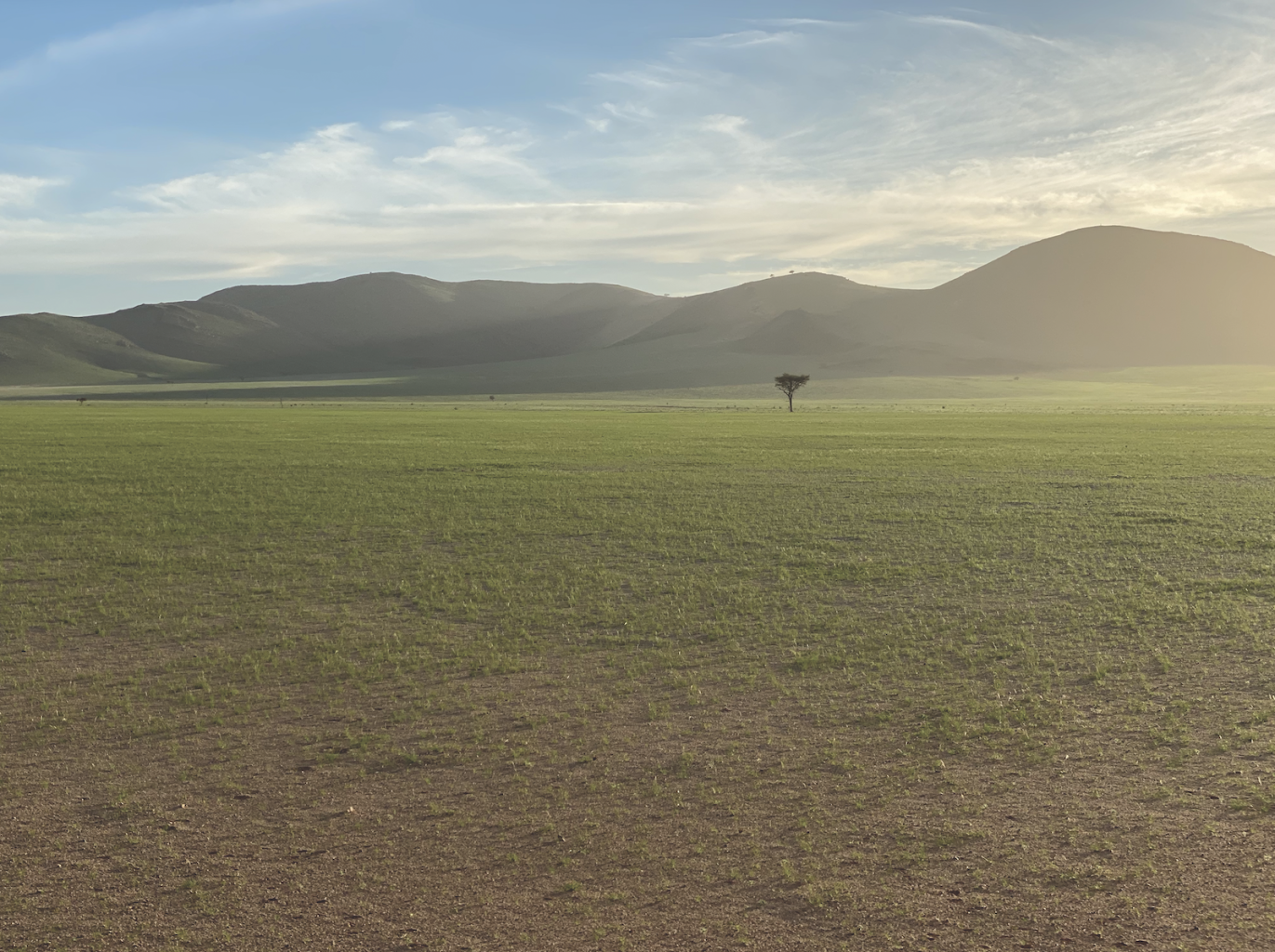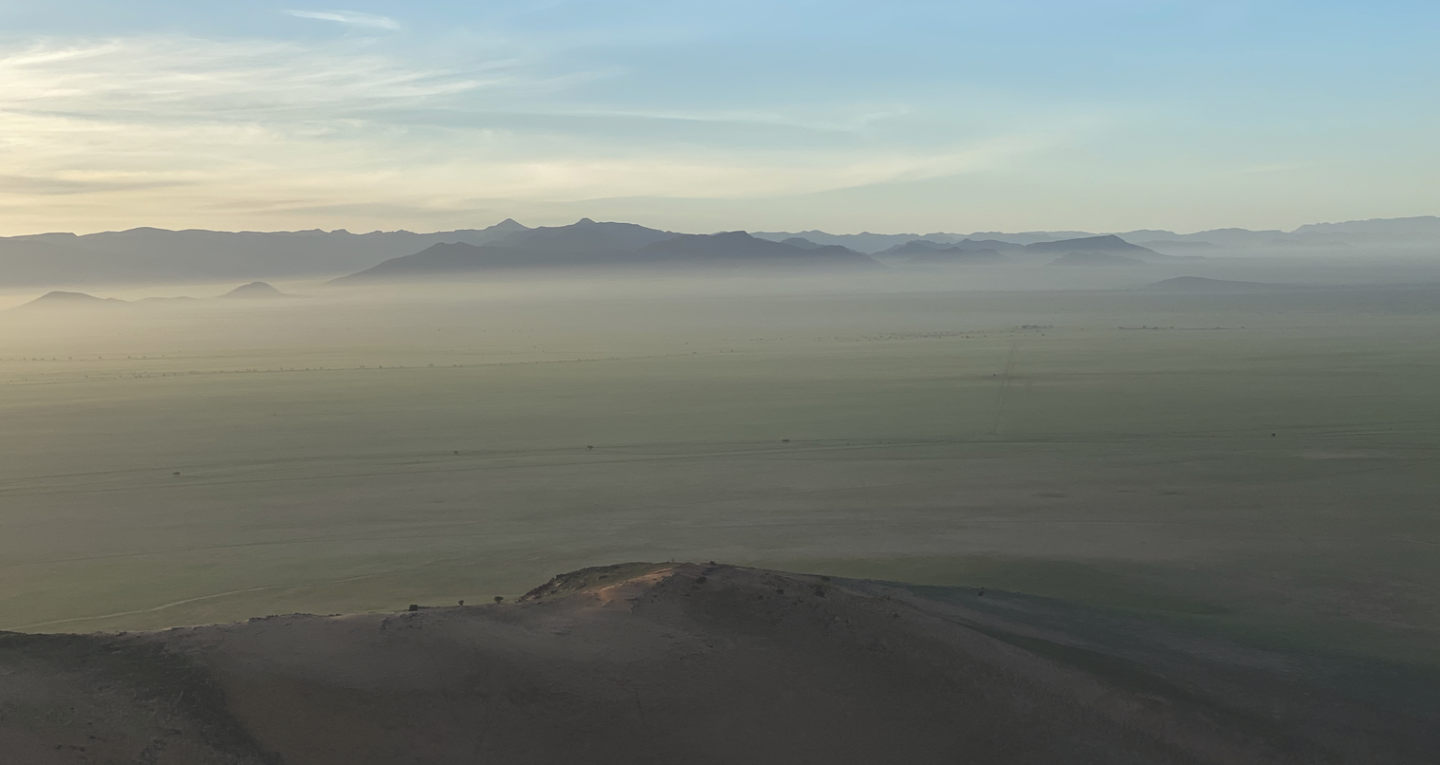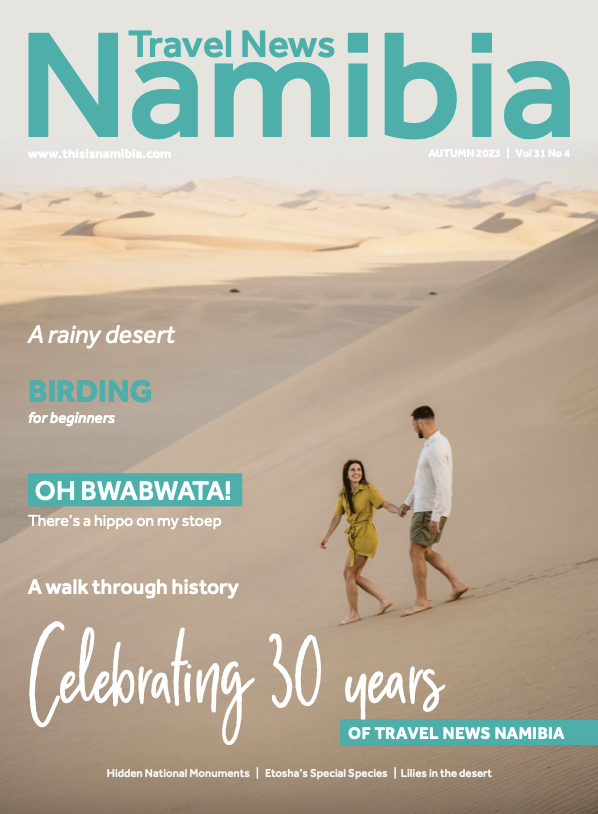

Delighting in Desert Rains
Abundant rains have fallen in the desert. Words that send every Namibian into a frenzy of excitement. Some will savour the photos taken of this phenomenon, while others will want to see this rare occurrence for themselves by packing their cars and heading out to the desert. This year, I’m one of the latter.
Text & Photographs Kirsty Watermeyer
From the Autumn 2023 issue
Rainfall in the Namib Desert is extremely scarce, and every drop is a welcome blessing. Don’t be fooled by this barren and dry landscape, though; this hinterland teems with life. But it does so secretively, only sharing these signs of life with the few that know where to look. When the rains fall in the desert it is as though this land holds out its hand, inviting all to come see how alive it really is. It is a welcome, a request to come and see the transformation. Yet, even seeing it with your own eyes is surreal.
Our journey to this transformed landscape sees us depart Windhoek heading south. We are taking the scenic route, heading towards Rehoboth and then turning off on the C24 until we turn onto the D1261. It is a route, made up of mostly gravel roads, which will lead us to the desert via Spreetshoogte Pass where we plan to stop and take in the sprawling views. Just before we reach the pass, while still on the D1261, we spot a small coffee shop along the side of the road. The owner, Sonia Rabie, delights us with stories of the many visitors she’s already had today. It seems that, like us, many are heeding the call of a green desert.
Not long after this stop, we arrive at Spreetshoogte Pass. This mountain pass traverses the Great Escarpment, a major geological feature in Southern Africa, and is the steepest pass in Namibia. The panorama along this pass makes you feel like you can see to the edge of the globe. Here we have the sense of having all the time in the world, as we breathe in the feeling of space and expanse. In the valley below, the earth looks soft and delicate, bathed in green and purple hues. It is a taste of what is to come.
From Spreetshoogte Pass we travel onwards to the desert. We are staying at The Desert Grace, a lodge that has been described as “old Hollywood glamour amalgamated with the colours of the rolling dunes of the Namib”. I concur. It is beautiful, with its pink colour scheme and endearing attention to detail. It also boasts most welcome features, such as an ice-cream stand – a rarity in the heat of the desert.
The sun is hanging low on the horizon as we arrive. It is painting the sky with a kaleidoscope of colours. We marvel at this masterpiece of moving art as we sip sundowners and plan our visit to Namib-Naukluft National Park. Tomorrow we’re going swimming in the desert.
The next morning, while the remnants of night are still about, we collect our picnic brunch that the lodge has prepared for us. We also make sure that our cooler box is packed, as we are very aware of the heat that awaits us despite the recent rains. After one final check to ensure we have enough rehydration, we’re off, heading towards Sossusvlei.
Sossusvlei is situated in the largest conservation area in Africa, Namib-Naukluft National Park, which covers almost 50,000 km2. The Sossusvlei Pan is large, white, and consists of salt and clay – the name literally translates to “dead-end marsh”. It is the place in the desert where the dunes come together, preventing the Tsauchab River from flowing any further. Due to the dry conditions in the Namib, the river seldom flows this far and the pan remains bone-dry most years.
Driving through the desert en route to the pan, we see early signs of the recent rainfall, with swathes of bright green grass carpeting the ground. One traveller remarks that it looks as though a lush golf course has opened in the desert.
The air feels different, plump with water as opposed to its usual thin and vacant feeling. Usually the desert, in its desperate need for water, seems to syphon water out of anyone and anything which dares cross its threshold. Now the abundance of water is enough to leave some in the atmosphere. It makes the light look different, like a soft haze.
Characteristic pink and orange sand dunes – given their colour due to the high concentration of iron in the sand and consequent oxidation processes – are now contrasted with a remarkable variety of greens. In amongst the array of greens, purple colours paint the edges. It is a feast for the eyes in a usually barren environment.
Before arriving at the pan, we stop to marvel at this desert transformation. Even up close, it is not what you would expect. The green carpets comprise delicate grasses interspersed with exquisite and wide-ranging miniature desert flowers. Petite and pretty, these tiny flowers are entertaining a multitude of insect life – both the crawling and flying varieties. The usual sounds of silence synonymous with the desert have been replaced with the hum of life, the reverberation of growth.
The usual streams of cars heading towards Sossusvlei accompany us, everyone eager to see water in the pan. It is a rare sight. A resounding gasp of delight fills our car as we arrive at the traditionally white pan of Sossusvlei, now filled with water. It is a true desert oasis where the twinkle of the sun reflecting on the water catches your eye. We unpack camping chairs and set up our picnic spot under a camel thorn tree. Many people are here, their campsites for the day dotted along the water’s edge. They too are enjoying a swim in the desert today. Fortunately the pan is big enough for us to find a quiet corner where we are the only people floating in the stillness of this desert pool. It is magical and otherworldly.
Without a care in the world we float along, admiring the picturesque surroundings. This is until our appetite draws us out of the water and to our packed picnic baskets. After enjoying the desert breeze for some time, we head off to Sesriem Canyon. Our swimming adventures are not at an end yet because there are more water wonderlands to explore.
Sesriem Canyon is located just inside the entrance gate of Namib-Naukluft National Park. The canyon formed about two million years ago when the powerful Tsauchab River cut its way through the sedimentary rock, creating a gorge with a depth of between 30 and 40 metres. It is also the Tsauchab River which has filled up the canyon, creating captivating swimming opportunities between the rugged ravine walls. Absorbing formations carved on the walls of the gorge are evidence of how erosion created a masterpiece of art, a sculpture of rock if you like.

But there is another optical spectacle on offer. When you arrive at the canyon it seems as if there is nothing to see, until you come to a path that leads to a small staircase taking you towards the entrance of the canyon. Interesting rock formations provide the gallery as you descend to the edge of the water. It is an easy walk down and the reward is plentiful, as refreshing waters await. Some swimmers choose to climb boulders and jump off into the streams below; others are content to float along and marvel at the geology.
I have been here before and know from past experience that the clay in the water can stain your swimwear. This is why you would be best advised to swim in something you are not too attached to or don’t mind being stained. But today, this doesn’t stop any of us, or any of the other visitors to the canyon. We are all too eager to cool off from the heat of the desert.
At the end of the day, our hearts are full and our bodies tired from the day of wonder and exploration. Today we have amassed stories to tell and memories to cherish. Tomorrow we’ll explore this wonderland from the sky.
Again we have an early morning departure from the lodge as we head towards Solitaire, a small desert town described as a remote settlement at the edge of Namib-Naukluft National Park. We are rewarded for rising in the flush of morning with sights too incredible to imagine. En route, the rare and crepuscular bat-eared fox crosses the road in front of our vehicle, an early promise of a thrilling day ahead.
After meeting the owner and pilot at Samawati Hot Air Ballooning, John De Almeida, we take to the skies to see the desert transformation from above. Nothing could prepare us for the beauty we experience as we float over the Tsondab Valley. The landscape is famously unique, home to petrified dunes, marble mountains and vast plains. Following the lavish rains, it is an arresting sight.
The silence is met only by gasps as the group of intrepid aeronauts marvel at the luminous carpet beneath. The land below us lies in ethereal beauty. It is a marriage of the ancient desert terra firma, consisting of rocks and sand, capped with delicate greenery. The rains have brought moisture to the air, creating a transparent fog-like softness to the sky. In the serene silence, the desert has humbled us.
Once back on land, we notice that the rainbow of colours we perceived from the skies are made up of not only grasses sprouting life through sandy plains but also of an array of miniature desert blooms. The shapes and colours are endless, and leave much to explore. Our group, now comrades after this adventure, compare findings and stories of our experience of a desert transformed while we enjoy a champagne brunch – a tradition since hot air balloons first took flight. We all agree that we felt a sense of being welcomed by the desert, beckoning us to see it adorned in the colour synonymous with life – green.
Our short trip to see the marvel of a barren land metamorphosing into a whimsical expanse of new life has come to an end. We’ll leave changed somehow, as the desert has reminded us of the necessity and ease of change.







